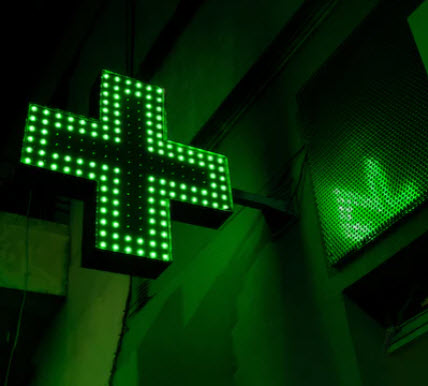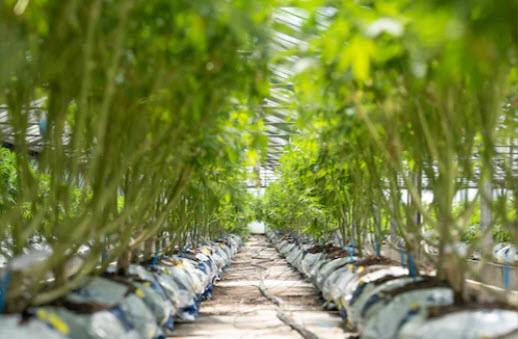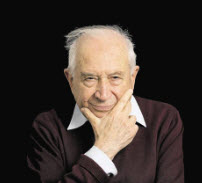In a decision so far widely uncovered by the cannabis press, pharmacies are now unable to charge any markups for domestically cultivated medical cannabis – although they will make money on preparing the same for dispensation to patients. Imports remain unaffected. What impact will this have on both the medical and now pending recreational cannabis market?
In a bit of intriguing news only now filtering out of law firms and the German pharmaceutical specialty press, a new ruling is set to dramatically change the face of the entire German cannabis conversation. It won’t be immediately noticeable to anyone but German pharmacies and insurers and is valid until June 30, 2023. If no new contract is renegotiated, the terms will be extended.
That is unlikely to happen. Pharmacies were very unhappy with the decision. In fact, as of the first announcement in the German specialty press, the German Pharmacists’ Association (DAV) was considering filing suit (although this apparently has not occurred).
What this development will inevitably do, however, is open up a discussion about how much pharmacies should be allowed to mark up cannabis no matter where it is produced – in addition to their preparation fee – and beyond that, will have an almost certain impact on pricing in the coming recreational market.
The Details
Up until this decision in June, German pharmacies were allowed to buy domestically cultivated cannabis from Cansativa for 4.30 euros per gram. Cansativa, the sole distributor, won in a competitive bid via BfArM, was allowed to make 2.10 euros per gram on cannabis bought from the three domestic producers who were also required to sell the same to Cansativa at 2.20 per gram. This was set in the German cultivation bid.
Pharmacies could then be compensated by insurers for up to 9.52 per gram, plus surcharges. This amount was reduced by volume per patient (with the price breaks hitting at 15 grams per month.) The minimum fee was 8 euros per gram. This means that pharmacies were able to mark up cannabis flower by as much as 5.32 euros per gram of cannabis sold, beyond prep fees.
No more.
After five hearings between the Central Association of Statutory Health Insurance (GKV) and the DAV and a failure to reach a determination equitable to both parties, the price of compensation to pharmacies of medical cannabis grown in Germany has been set via arbitration. Pharmacies can only sell the same at 4.30 euro a gram. In other words, they will not be allowed any markup at all.
That said, they will also then be able to add a surcharge for preparation which will be between 90-100% more than their purchase price. This amount will bring the total reimbursable amount per gram to about what it is now, minus extra prep fees. The price of 9.52 euro per gram applies only to the first 15 grams per month per patient and then drops to about 8 euro over that.
This new agreement does not set levels of reimbursement per patient based on volume. This means that pharmacies will be able to charge insurers up to 8.60 euros per gram of cannabis sold, no matter how much they dispense per patient.
However, what the ruling does do, which is to apply retroactively to 1 June 2021, is remove any pharmacy markup from domestically produced cannabis.
Six of One, Half Dozen of the Other?
On one level this is academic. The difference in the price of cannabis sold at pharmacies will be largely offset by surcharges that insurers (aka the government) will pay to the dispensing pharmacies – ultimately underwriting the cost of at least pharmaceutical preparation of cannabis even more.
This in effect, also formally shifts the bulk of compensation for cannabis cultivated in Germany away from the producers and the one distributor in the middle and towards pharmacies. German pharmacies, in effect, will be paid more than any other part of the supply chain for “preparing” cannabis to sell, rather than being allowed to introduce a markup plus prep fees. On the positive side, they will also be protected from cannabis spoilages – as the new agreement also sets a price for cannabis that has to be destroyed if not sold.
One way to look at this is that pharmacies will actually make more per gram on domestically cultivated cannabis overall as a piece of the pie once preparation fees are included, even if they cannot charge a markup on the product itself to cover other charges, such as storage.
It is a clumsy compromise and leaves a great many loose ends if not grey exception areas.
Beyond hard costs associated with cannabis dispensation, imported cannabis is the other big question mark. While cannabis cultivated outside of Germany will not be subject to the same price bands (in other words pharmacists can still mark such cannabis up), this new decision does not necessarily create a huge boon for foreign producers either – who also face considerably higher costs in getting the cannabis into the country, not to mention distributors who, in addition to logistics, also have to “educate” doctors into prescribing the same. They may be able to sell it for more than domestic producers or Cansativa, in other words, as will pharmacies, but the same surcharges will not necessarily apply. The risks from spoiled cannabis will also remit most immediately if not fully to the distributors and the pharmacies.
This decision certainly has, in effect, created a defacto standard sales price, as well as set distribution and preparation fees.
Are There Any Silver Linings?
One way to look at this development is that the government is underwriting cannabis preparations – and subsidizing pharmacies along the way while also keeping the basic remuneration to the supply chain the same.
This decision also does not necessarily make the cost to insurers all that much less. Theoretically, it also does not significantly reduce the amount of money the pharmacies will receive – it just makes the reimbursement schedule more rigid and less negotiable.
However, what it does do is create a different environment for imported cannabis – which both is and is not applicable here. Namely, such cannabis can be sold (and reimbursed) at the “old” rates.
While it will not ultimately, significantly reduce the cost of cannabis to insurers, it may impact the medical discussion going forward – as well as the recreational market.
That said, for now at least, the import market remains unchanged.
What Is the Immediate Impact Likely to Be?
The ultimate impact of this ruling is that it may incentivize domestic pharmacies to buy foreign cultivated cannabis.
Beyond this? While cannabis imported into the country is reimbursable at the “old” prices – namely up to 9.52 euros per gram, reduced by price breaks (plus surcharges) – this means that both distributors and pharmacies would actually be in line to make more. But here is the rub – not necessarily.
This is because the reimbursement prices decrease with volume on imports – they do not with the new prices set by the government with this ruling.
In effect, the total reimbursement pie is just being split differently.
The Other Impacts
The German government appears to want to tightly regulate prices in the domestic market at every step of the way. This is, beyond any hangover on wanting to keep the cultivation, processing, and manufacturing business out of the country for as long as possible, rather short-sighted. For one thing, it will probably end up being a boon to foreign producers who understand how to maneuver their way through the considerable barriers to market entry that currently exist.
It remains to be seen how it will impact the pharmacies.
Beyond this, it also creates a rather interesting line in the sand on the pricing front – particularly if the German government decides to expand this decision. Namely, it is clear that the government is taking the position that even GMP cannabis can be grown in Germany (in other words inside) for about 1.10 euro per gram. This in turn does put pressure on foreign producers who are competing with the same. Namely, even though they can charge more for their product, they still have to invest in medical education to convince doctors to prescribe their strains (which is expensive) beyond all the other logistics costs involved.
To date, pharmacies have not been involved in such efforts.
How Will This Affect Pending Recreational Prices?
What this decision might well do is create a set price for all cannabis cultivated in Germany – and at every step of the supply chain – even if not of the GMP variety. In fact, it could drastically reduce the cost of any recreational cannabis cultivated in the country – thereby setting up both a cultivation and point of sale price that is highly competitive with the black market.
If non-GMP cannabis is sold into dispensaries at about the same price (or just lower than) German medical cannabis, it also begins to rough out a tax structure for the emergent recreational industry that allows such product to be highly competitive with the black market – and in a situation unseen anywhere else – still be fairly highly taxed at the same time. However, this brings up another issue. How much will dispensaries be allowed to mark up domestically grown cannabis, particularly as no prep fee will be involved.
Bottom line? The pharmacies are very unhappy. Some believe this will give foreign cultivators an advantage. That said, predictions of this kind are frequently short-lived, given all the complexities involved.
The only certain thing? German-grown cannabis just got more regulated. How this will stack up, ultimately, to the foreign market, not to mention the pending recreational one is still very much a matter for discussion.









